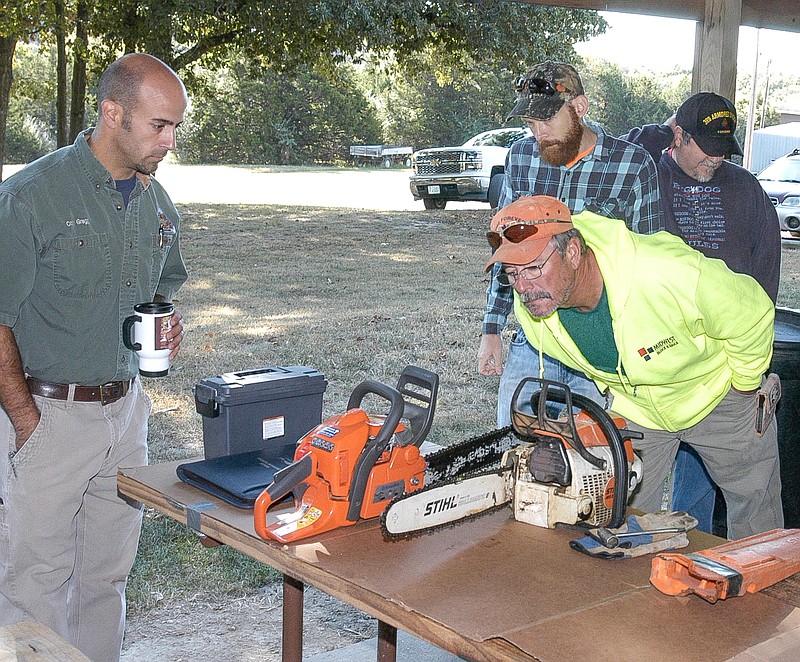Safety was the emphasis of instructor Joe Glenn at the Conservation Department chainsaw safety training event held locally Sept. 29-30.
The safety taught included protective equipment, proper saw maintenance, proper sharpening techniques, safe felling techniques for a variety of circumstances, as well as bucking and limbing hazards.
In short, it is not advisable for someone to grab a chainsaw and start cutting trees, shrubs or brush.
At least some expertise should be sought, before anyone picks up a chainsaw and goes out to cut a tree.
This two-day event was attended by nearly a dozen chainsaw users. It was conducted by Glenn, who is nationally-known in the field of chainsaw training and competition. The event was offered by the Missouri Department of Conservation for woodland owners in mid-Missouri.
The all-day classroom session was held Sept. 29 at the California Shooters Club, near McGirk. Following the workshop session Sept. 30, which was also at the Shooters Club facility, the group relocated for the practical application of chainsaw use to the Roger and Viola Wachal Smith Conservation Area, north of Centertown.
Glenn spoke of being a logger for 12 years, before attending four-day timber-cutting school. There, he was introduced to chainsaw safety by the "Game of Logging" chainsaw training curriculum, developed in the 1960s by Soren Eriksson, a Swedish logger turned training instructor.
Now, Glenn has also turned from logger to training instructor.
Emphasis was on safety throughout the class sessions.
"You might have come here for one thing, which could save you," Glenn said.
Although the chainsaw use discussion dealt with techniques to use for cutting trees down, cutting up downed trees, cutting limbs off and cutting small trees and brush; personal and equipment safety were discussed at length.
Personal protection equipment is very important, according to Glenn. These include a hardhat, hearing protection, face protection, first aid kit, and chainsaw-proof leg and foot protection.
The chainsaw itself should be safe for operation. A chainsaw should have a chainbrake, a throttle lock out, a chain catcher and muffler. Above all, everything should be present and in working order.
Glenn had strong recommendations for increasing chainsaw safety by using specific tree-cutting methods.
Contrary to methods used by many, if not most, self-taught chainsaw users, he spoke at length about the notch cut on a tree in the direction it is intended to fall.
Many have just used a small notch, maybe 25 to 30 degrees, especially if the tree is intended for long-board use. Glenn advised starting from above at a steep angle downward to make a cut of at least 70 degrees - straight cut in at the bottom of the 70 degree cut, to meet the angled cut.
Then, go to the other side and cut through to allow a "hinge" for the tree to bend down on. This type of cut is safer and less likely to cause the base of the cut tree to slip back and injure the chainsaw user.
He also recommended using a "bore cut" on the back side, leaving a small part of the wood for a "trigger." When the trigger is cut, the tree fall will be more likely to be under control.
Once in the field, Glenn emphasized having a tree-falling pre-plan. That begins with checking the area out for anything that could be harmful, such as dead limbs, hanging limbs, vines, dead trees, and so on.
Sometimes there are so many hazards around a tree, that it is not safe to cut.
There is also the way a tree is leaning, the weight distribution, what the tree is like and more. For instance, a hollow tree brings its own set of hazards, as do trees that splinter when cut. The species of a tree also may determine how it is to be cut.
His basic advice is, "if you don't think it is safe, definitely don't do it." If one has looked over the situation and doesn't feel comfortable, don't do it. And above all, make sure one has one's safety equipment and make certain one's chainsaw safety features are present and fully functional.

